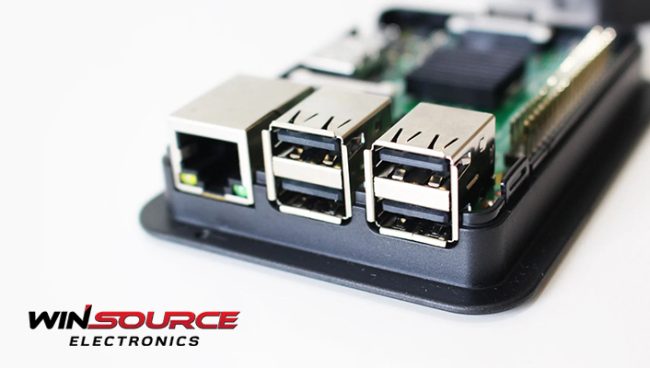
A single board computer (SBC) is a complete computing device built on a single circuit board. It integrates all the necessary components of a typical computer, including a processor, memory, input/output ports, and storage, onto a compact board. Despite its small size, an SBC operates as a standalone computer capable of performing various tasks.
How Does Single Board Computer Work?
An SBC’s central processing unit (CPU) executes instructions and processes data. These CPUs can vary in power and architecture, ranging from essential ARM-based processors suitable for lightweight applications to more powerful x86 processors capable of handling demanding tasks.
Memory on an SBC typically includes RAM (Random Access Memory) for running programs and temporary data storage. Some boards also have onboard storage like eMMC or flash memory, while others rely on external storage through USB or microSD cards for data retention.
The board includes various ports and connectors for interfacing with peripherals and external devices. These ports can consist of USB, HDMI, Ethernet, audio jacks, GPIO (General Purpose Input/Output) pins, and more. These connectors enable users to attach displays, input devices like keyboards and mice, network connections, and additional hardware for customization.
SBCs come in various form factors and sizes. The most common size is the credit card-sized boards, such as the Raspberry Pi series, which have gained immense popularity due to their affordability, versatility, and strong community support.
Larger SBCs, like the NVIDIA Jetson series or the Intel NUC (Next Unit of Computing), offer more powerful processing capabilities and are used in applications requiring higher performance, such as AI, robotics, and edge computing.
Benefits of Using Single Board Computer
One of the significant advantages of SBCs is their versatility and flexibility. They serve a wide range of purposes across numerous industries. Hobbyists and DIY enthusiasts use them for home automation, media centers, retro gaming consoles, and educational purposes. In education, SBCs have become valuable tools for teaching programming, electronics, and computer science concepts in a hands-on and accessible manner.
Moreover, SBCs have found applications in industrial settings, serving as controllers for machinery, IoT (Internet of Things) devices, and embedded systems due to their compact size and ability to operate in various environments. They are also utilized in prototyping and product development, allowing engineers and developers to quickly test and iterate on ideas before scaling up to larger systems.
Affordability: SBCs are often significantly more affordable than traditional computers or development boards. Their cost-effectiveness makes them accessible to hobbyists, students, and budget-conscious projects.
Compact Size: Being small in size, SBCs are portable and can fit into tight spaces. This feature is particularly advantageous in applications where space is limited or in portable devices.
Low Power Consumption: SBCs generally consume less power than standard computers, making them ideal for energy-efficient applications, especially in scenarios where power consumption is a concern, such as in IoT devices or remote installations.
Versatility: These boards support a wide range of operating systems and applications. Users can run various flavors of Linux, Android, or even Windows on certain SBCs, enabling software development and experimentation flexibility.
Educational Tool: SBCs are excellent educational tools for teaching programming, electronics, and computer science. Their affordability and accessibility make them perfect for learning and experimentation in a classroom or individual setting.
Rapid Prototyping: SBCs facilitate rapid prototyping and proof of concept in product development. Engineers and developers can quickly test ideas, iterate designs, and validate concepts before committing to larger-scale production.
IoT and Embedded Systems: SBCs are widely used in IoT devices and embedded systems due to their small form factor and ability to integrate various sensors and communication modules. They serve as the brains of many IoT applications, connecting devices and collecting data.
Customization and Expansion: Most SBCs come with GPIO pins and multiple ports for interfacing with external hardware, allowing for customization and expansion. This feature is valuable for creating tailored solutions in robotics, automation, and specialized projects.
Community Support and Ecosystem: SBCs often have large and active communities, resulting in extensive documentation, tutorials, and a broad range of compatible hardware and software. This support network fosters innovation and assists users of all levels of expertise.
Scalability: Some SBCs, while small in size, offer considerable processing power. They can be scaled up to handle more complex tasks by clustering multiple boards together, enabling parallel processing for demanding applications like AI and data analysis.
The open-source nature of many SBCs contributes to their widespread adoption and community-driven innovation. Community support often leads to extensive documentation, tutorials, and a vast ecosystem of compatible hardware and software, fostering creativity and making SBCs accessible to users of varying skill levels.
In summary, a single-board computer condenses the essential components of a computer onto a single, compact board.
In essence, SBCs’ benefits lie in their versatility, affordability, and adaptability across numerous applications, making them valuable tools for hobbyists, educators, engineers, and businesses alike.
WIN SOURCE seems like a reliable hub for electronic components, especially for sourcing hard-to-find or obsolete parts. Their extensive inventory and dedication to assisting customers in procurement are notable. They’ve built a platform with value-added services, ensuring quality and authenticity through certifications and memberships. Offering a 3-year warranty on original parts and emphasizing fast delivery, they strive to optimize the sourcing experience. Their commitment to continual improvement and customer service excellence shapes their business philosophy, making them a go-to for various electronic component needs. They’re set to meet evolving industry demands with a user-friendly interface and global growth plans.
© 2024 Win Source Electronics. All rights reserved. This content is protected by copyright and may not be reproduced, distributed, transmitted, cached or otherwise used, except with the prior written permission of Win Source Electronics.

COMMENTS